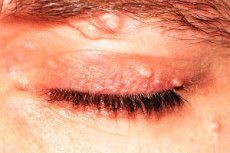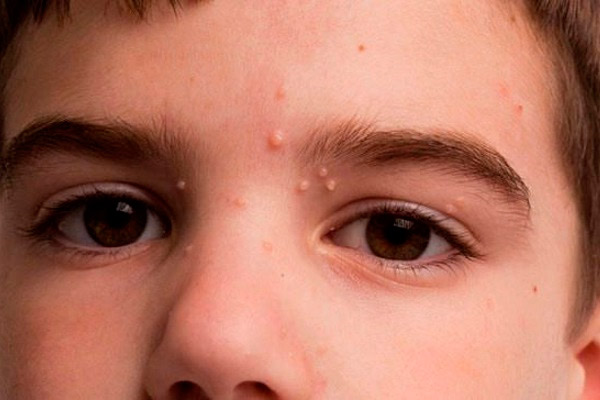Medical expert of the article
New publications
Contagious molluscum on the eyelid: causes, symptoms, diagnosis, treatment
Last reviewed: 05.07.2025

All iLive content is medically reviewed or fact checked to ensure as much factual accuracy as possible.
We have strict sourcing guidelines and only link to reputable media sites, academic research institutions and, whenever possible, medically peer reviewed studies. Note that the numbers in parentheses ([1], [2], etc.) are clickable links to these studies.
If you feel that any of our content is inaccurate, out-of-date, or otherwise questionable, please select it and press Ctrl + Enter.

What causes molluscum contagiosum of the eye?
Caused by dermotropic poxvirus. This nosological form is well known not only to ophthalmologists, but also to pediatricians and dermatologists. It should be noted that the term "infectious" is fundamentally incorrect. It appeared at a time when it was believed that the disease owed its origin to a protozoan mollusk penetrating the skin. Despite the fact that the viral origin of the disease has now been precisely established, the old term is still in force. The dermotropic virus causing the clinical picture is transmitted by direct contact, as well as through objects, in particular toys.
How does molluscum contagiosum of the eye manifest itself?
White round nodules with a depression in the center appear on the skin of the eyelids or along the edges of the eyelids. When the nodule is squeezed, a mushy mass is released from its depression. Often complicated by persistent follicular conjunctivitis.

The clinical picture of the lesion consists of the appearance of single or multiple nodules on the skin, ranging in size from a damask head to a pea. The nodules are dense, painless to the touch, have the color of normal skin, sometimes with a peculiar shine, reminiscent of the shine of a pearl. The presence of a depression with microscopically small holes in the center of the nodule is typical. When the nodule is squeezed, a white mass is released through them, consisting of degenerated elements of the dermis. At one time, this content was considered the causative agent of the disease.
Contagious molluscum of the eye can cause persistent viral blepharitis, conjunctivitis and keratitis, and these diseases occur regardless of the localization of the molluscum. In cases where the lesions are on the eyelids, the origin of the listed diseases is undoubtedly viral. Blepharitis and keratitis, which occur on the basis of this disease, usually do not differ in any specific clinical manifestations. As for conjunctivitis, it is characterized by the presence of fairly large follicles, resembling follicles in appearance in trachoma.
What do need to examine?
How to examine?
How to treat molluscum contagiosum of the eye?
Contagious molluscum of the eye is treated well. Skin elements are destroyed by scraping or diathermocoagulation followed by cauterization of the molluscum bed with a 1% solution of brilliant green. Blepharitis, conjunctivitis and keratitis after the elimination of all molluscum nodules disappear without a trace without any treatment.
Contagious molluscum on the eyelid is treated by excising the nodule or scraping it with a sharp spoon, followed by cauterization with an alcohol solution of brilliant green; the affected area can be treated with an electrocoagulator.


 [
[